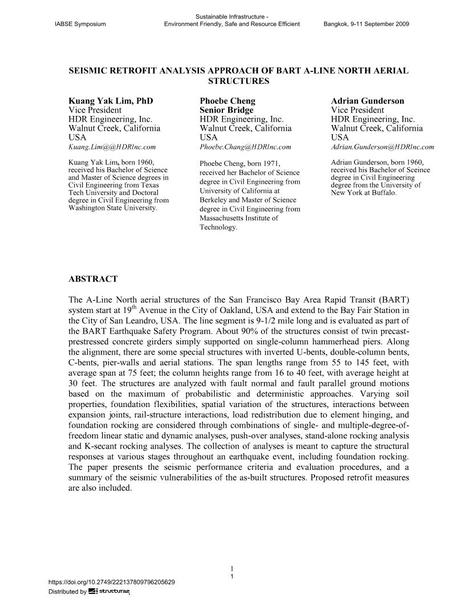Seismic Retrofit Analysis Approach of Bart A-Line North Aerial Structures

|
|
|||||||||||
Bibliografische Angaben
| Autor(en): |
Kuang Yak Lim
Phoebe Cheng Adrian Gunderson |
||||
|---|---|---|---|---|---|
| Medium: | Tagungsbeitrag | ||||
| Sprache(n): | Englisch | ||||
| Tagung: | IABSE Symposium: Sustainable Infrastructure - Environment Friendly, Safe and Resource Efficient, Bangkok, Thailand, 9-11 September 2009 | ||||
| Veröffentlicht in: | IABSE Symposium Bangkok 2009 | ||||
|
|||||
| Seite(n): | 88-108 | ||||
| Anzahl der Seiten (im PDF): | 21 | ||||
| Jahr: | 2009 | ||||
| DOI: | 10.2749/222137809796205629 | ||||
| Abstrakt: |
The A-Line North aerial structures of the San Francisco Bay Area Rapid Transit (BART) system start at 19th Avenue in the City of Oakland, USA and extend to the Bay Fair Station in the City of San Leandro, USA. The line segment is 9-1/2 mile long and is evaluated as part of the BART Earthquake Safety Program. About 90% of the structures consist of twin precastprestressed concrete girders simply supported on single-column hammerhead piers. Along the alignment, there are some special structures with inverted U-bents, double-column bents, C-bents, pier-walls and aerial stations. The span lengths range from 55 to 145 feet, with average span at 75 feet; the column heights range from 16 to 40 feet, with average height at 30 feet. The structures are analyzed with fault normal and fault parallel ground motions based on the maximum of probabilistic and deterministic approaches. Varying soil properties, foundation flexibilities, spatial variation of the structures, interactions between expansion joints, rail-structure interactions, load redistribution due to element hinging, and foundation rocking are considered through combinations of single- and multiple-degree-offreedom linear static and dynamic analyses, push-over analyses, stand-alone rocking analysis and K-secant rocking analyses. The collection of analyses is meant to capture the structural responses at various stages throughout an earthquake event, including foundation rocking. The paper presents the seismic performance criteria and evaluation procedures, and a summary of the seismic vulnerabilities of the as-built structures. Proposed retrofit measures are also included. |
||||
| Stichwörter: |
Pushover-Analyse
|
||||
